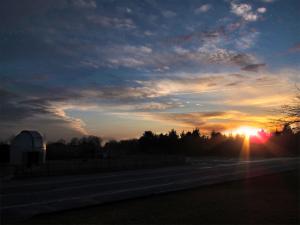Sunrise, Sunset
I fashion myself a crepuscular mammal; alert and active at dawn and dusk, I gain inspiration from the subtle interplay of the changing light at the ends of the day. Be it hopeful anticipation as the rising sun infuses the sky with its warm radiance, or the peace and serenity evoked as it sets, I love these times of day.
I’m reminded of a 12 year old camper casually asking his counselor why the sun is red at dawn and dusk. And I’m still appreciative of his skill in answering the question. Sensing a teaching moment, he clearly and thoughtfully enthralled me with his reply. It is in honor of that moment etched in time that I attempt to succinctly explain why our brilliant sun should appear as it does at these magical times of the day. To the extent that I succeed, I owe it to a young man who captured a child’s imagination, and forged an appreciation of these truly miraculous moments.
We know that the atmosphere of earth exists within a narrow band enveloping the earth, gradually giving way to the black void of space about 62 miles/100 km high. So, if space is black, as is common knowledge, why does the sky appear blue during the day, and at other times yellowish, orange, or, red?
Turns out it has to do with the angle of the Sun, and the amount of atmosphere that the sunlight passes through. As well, different colors within light’s spectrum tend to scatter, more, or less, depending on their wavelength. Finally, particulate matter, such as dust or smoke in the atmosphere, also affects the color of the setting and rising Sun.
During the day, the Sun’s blue light rays are selectively scattered by air molecules, and produce the blue sky away from the Sun’s direction. The Sun’s violet light is scattered even more efficiently than blue rays, but our eyes aren’t as sensitive to violet, and there is not much violet light coming from the Sun, anyway. And, green light is not scattered as efficiently as blue, so blue becomes the predominant color of the daytime sky.
The setting Sun, however, progresses through a range of color, from white to yellow, to orange and, sometimes, to red. As the Sun rises in the east, the color progression is reversed. Why the changing colors?
Closer to the horizon, sunlight travels through a longer atmospheric path, causing more scattering of light. Yellow, orange, and red light are scattered out of your line of sight less than violet, blue, or green. The yellow, orange, or red light is more likely to reach our eyes, making the Sun appear that color.
Also, violet and blue light are more easily absorbed by dust and smoke in the air, as is green light to a lesser degree. The more smog, dust, or other pollution in the air, the more absorption of violet, blue, and green light there will be, producing a more orange or red sunrise or sunset. Our reddest sunrises and sunsets are produced by our smoggiest skies. Of course, any present clouds reflect the setting Sun’s rays, adding color and beauty to the sky.
Sunrise and sunset are powerful times of the day. They call forth strong emotions, and easily bring to mind several refrains within musical lyrics, one being:
“Sunrise, sunset. Sunrise, sunset. Swiftly flow the days. Seedlings turn overnight to sunflowers, blossoming even as we gaze. Sunrise, sunset. Sunrise, sunset. Swiftly fly the years. One season following another, laden with happiness and tears.”
Sunrise and sunset are our clocks. They mark and frame our days’ and our time on earth. They are always different, and always truly beautiful.
May you enjoy all your sunrises and sunsets!
Mark Sweberg
Your comments on this column are welcome. E-mail me at Mark Sweberg
- Author:
- Mark Sweberg
- Entry Date:
- Sep 10, 2013
- Published Under:
- Mark Sweberg's Columns


